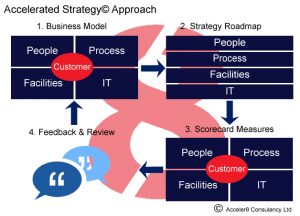Business Strategy: What creates failure? Flawed strategy or flawed execution – what’s the missing link?
Business strategy is the ‘choosing’, and execution is the ‘doing’. To refer this to the human body:
- The brain (top management) thinks and chooses (creates strategies)
- The body (the organisation) does what the brain tells it to do (execution).
We can see that the flow of information and flow of instructions is downwards from management to staff without any clear flow upwards. We will follow this concept through this blog.
Flawed strategy
As with most businesses, the flow of information or feedback to management is flawed or does not exist. This is down to creating and imposing executional tasks and instructions on employees where they consider management as distant and unwilling to listen. It becomes a double-edged sword for employees who find that if they report that things are going badly and question the strategy. They will either not be listened to and ignored or told off for not saying anything. When things are found out to have gone wrong they then feel they will get blamed for the outcomes. This leads to the employees acting against the strategy and withholding information valuable to the decision-making process.
For the business strategy to be successful, there needs to be the ability for employees to communicate. Feedback failing outcomes and issues of any projects to their senior management that allow for the opportunity for strategies need to be adjusted accordingly. This can be achieved through a cascading decision-making process. From the top of the organisation to the employees carrying out their day-to-day roles. Each level being a point where decisions can be made with each upstream decision affecting the decision immediately downstream.
Those at the top making the strategic long-term investments and employees who make day-to-day decisions, directly influence the overall running of the business. This is the equivalent of the human body’s natural feedback mechanism. For example, through our nervous system where strains and pains are fed back quickly and a suitable corrective response to the initial strategy is made. With each attempt the coordination of mind and body improves to the extent that previously unimaginable fetes can be accomplished.
Executional tasks
As a result, by using ‘executional tasks’ within business doesn’t encourage employee engagement and the flow of information to aid in any decision-making process. Therefore, you cannot say that the strategy is flawed or that the execution is flawed. Only that people are working independently of each other with very limited or no feedback loop.
The Accelerated Strategy© Approach has a positive reinforcement loop as it supports businesses in their own communication flow through an organisation. It enables early action with the benefit of market feedback which in-turn: 
- Achieves the highest Service Levels at the lowest operating costs, driving profitability.
- Aligns processes and offering to your product/service proposition, driving customer satisfaction.
- And finally – it allows for an easy refresh, enabling a quick response to changes in the market.
The framework enables employees to send information back upstream which then improves knowledge and understanding. This enables better decisions to be made throughout the business. A great way to empower your employees and the whole organisation then wins! Coming back to the human body, taking our approach is equivalent to training the body. Its response to achieve what it puts its mind to.
If you want to find out more on how Acceler8 can help with implementing and embedding strategy and employee engagement initiatives into your business without creating dependency on external support amongst a host of other consultancy services then please contact us….







